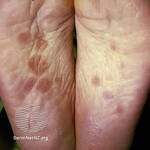
30 Sep USPSTF Recommends Syphilis Screening for Those at Risk
MedicalResearch.com Interview with:

Dr. Ogedegbe
Gbenga Ogedegbe, MD, MPH
Dr. Adolph & Margaret Berger Professor of Population Health
Director, Division of Health & Behavior
Director Center for Healthful Behavior Change
Department of Population Health
NYU Langone Health
NYU School of Medicine
Member of the U.S. Preventive Services Task Force
MedicalResearch.com: What is the background for this study?
Response: Syphilis has become more common over the past 20 years, after reaching a record low in 2000. The Task Force found that screening people who are at increased risk for syphilis can identify the infection early so it can be treated before problems develop. For that reason, the Task Force recommends screening people who are at increased risk for syphilis infection.
MedicalResearch.com: What are the main findings?

One example of secondary syphilis DermNet Image
Response: The evidence continues to show that it is beneficial to screen those at increased risk for syphilis. Without treatment, syphilis can damage the brain, nerves, eyes, and cardiovascular system. Fortunately, screening and follow-up treatment can cure syphilis and prevent complications.
When deciding who should be screened, healthcare professionals should consider how common syphilis infection is in the communities they serve and assess their patient’s individual risk. The risk of syphilis is higher in men who have sex with men, those with HIV infection or other STIs, and people who use illicit drugs. People with a history of incarceration, sex work, or military service are also considered to be at increased risk. Clinicians should use their judgment when determining how often to screen for syphilis and whether to combine it with screening for any other sexually transmitted infections.
MedicalResearch.com: What should readers take away from your report?

One example of secondary syphilis DermNet Image
Response: Screening for syphilis in those at increased risk is an important way to identify the disease so that people can be treated and cured. The Task Force has highlighted the fact that syphilis rates are higher in some racial and ethnic groups, with Black teens and adults being nearly five times more likely to have syphilis than those who are White. These disparities are primarily driven by social determinants of health such as differences in income level, education level, and access to coverage and care. These societal challenges can make it harder to maintain sexual health.
MedicalResearch.com: What recommendations do you have for future research as a results of this study?
Response: There are some important gaps in the current evidence. First, we would like to see more studies on risk assessment tools that can be used in primary care to help healthcare professionals better determine who is at high risk and who would benefit most from screening. We also want to understand more about what’s causing demographic and geographic health disparities, and to identify effective prevention strategies that may improve these inequities. We also need more information on optimal screening intervals for all high-risk populations and the effectiveness of rapid care testing compared to laboratory-based testing.
MedicalResearch.com: Is there anything else you would like to add? Any disclosures?
Response: It is important to note that this recommendation applies to adolescents and adults who have ever been sexually active and are at increased risk for syphilis infection. This recommendation does not apply to pregnant people or people who already have signs and symptoms of syphilis. The Task Force has a separate recommendation to screen for syphilis infection in all people who are pregnant, regardless of their individual risk.
Citation:
US Preventive Services Task Force. Screening for Syphilis Infection in Nonpregnant Adolescents and Adults: US Preventive Services Task Force Reaffirmation Recommendation Statement. JAMA. 2022;328(12):1243–1249. doi:10.1001/jama.2022.15322
Editorial: Gravett RM, Marrazzo J. Screening for Syphilis in Nonpregnant Adults and Adolescents. JAMA Netw Open. 2022;5(9):e2232168. doi:10.1001/jamanetworkopen.2022.32168
The information on MedicalResearch.com is provided for educational purposes only, and is in no way intended to diagnose, cure, or treat any medical or other condition. Always seek the advice of your physician or other qualified health and ask your doctor any questions you may have regarding a medical condition. In addition to all other limitations and disclaimers in this agreement, service provider and its third party providers disclaim any liability or loss in connection with the content provided on this website.
